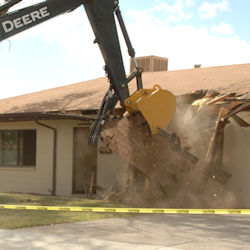Lead Dust
Lead in dust results from indoor sources such as:
- old lead paint on surfaces that are frequently in motion or bump or rub together (such as window frames),
- deteriorating old lead paint on any surface,
- repair activities,
- tracking lead contaminated soil from the outdoors into the indoor environment, or
- lead dust on clothing worn at a job site.
Exposure to lead dust is common when old buildings are demolished. Even in well-maintained buildings, lead dust can form when lead-based paint is scraped, sanded or heated during home repair activities. Lead paint chips and dust can get on surfaces and objects that people touch. Settled lead dust can re-enter the air when the building is vacuumed or swept, or people walk through it.
To reduce exposure to lead dust, it is especially important to maintain all painted surfaces in good condition, and to clean frequently, to reduce the likelihood of chips and dust forming. Using a lead-safe certified renovator to perform renovation, repair and painting jobs is a good way to reduce the likelihood of contaminating your home with lead-based paint dust.
Knowledge Check Choose the best answer for the question.
1-4. Lead-based paint can become hazardous when it is _____.
You forgot to answer the question!

